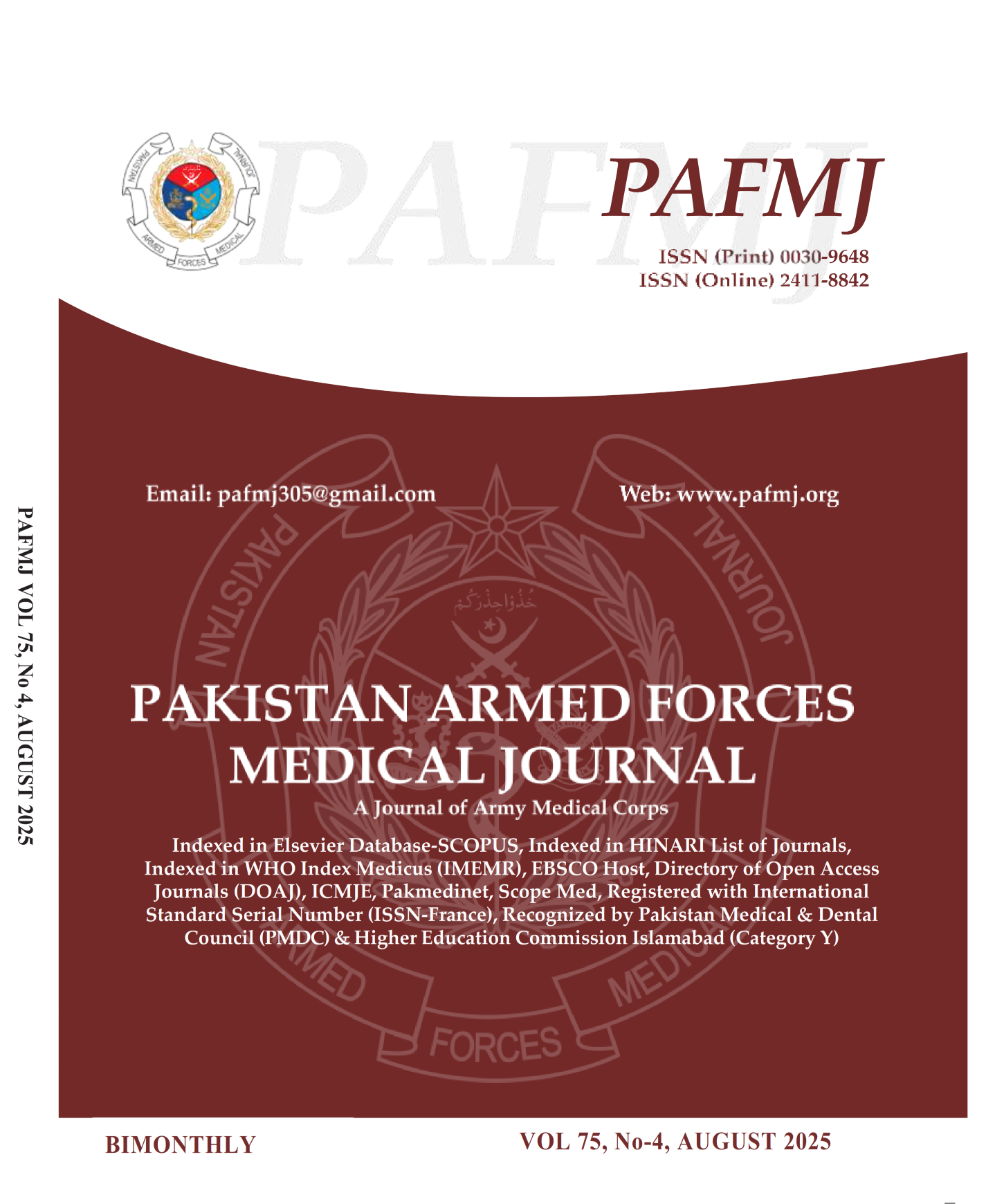Open AccessOriginal Article Frequency of Common Nerve Injuries in Patients with Oral and Maxillofacial Trauma
DOI:
https://doi.org/10.51253/pafmj.v75i4.11599Keywords:
Common nerve injury, Frequency of nerve injury, Maxillofacial Trauma, Neurosensory dysfunction (NSD)Abstract
Objective: To determine the frequency of common nerve injuries in patients with maxillofacial trauma and to compare the frequency of sensory and motor nerve dysfunction in these patients.
Study Design: Prospective longitudinal study
Place and Duration of Study: Oral and Maxillofacial Surgery Department, Armed Forces Institute of Dentistry (AFID), Rawalpindi, Pakistan from Mar to Dec 2023.
Methodology: A total of 190 patients with oral and maxillofacial trauma were reported to the Oral and Maxillofacial Surgery Department of the Armed Forces Institute of Dentistry. The study was conducted after approval from the Ethical Committee of the Armed Forces Institute of Dentistry.
Results: Out of 190 individuals, 176(92.6%) were male and 14(7.3%) were female. Whereas 72 patients (37.8%) presented with trigeminal nerve injury, and 118 patients (62.2%) did not. Out of the nerve injury patients, 16(22.2%) had ophthalmic sub-branch injury, 22(30.5%) had maxillary nerve injury, and 34(47%) had mandibular nerve injury. 4 patients (2.1 %) with peripheral facial nerve injury and 186 patients (97.9%) without facial nerve injury were identified.
Conclusion: The majority of maxillofacial trauma patients were young. Males significantly suffered more from oral and maxillofacial trauma as compared to females. The trigeminal nerve was damaged more as compared to the facial nerve in these craniofacial trauma patients.
Downloads
References
1. Roccia F, Iocca O, Sobrero F, Rae E, Laverick S, Carlaw K, et al. World Oral and Maxillofacial Trauma (WORMAT) project: A multicenter prospective analysis of epidemiology and patterns of maxillofacial trauma around the world. J Stomatol Oral Maxillofac Surg 2022 ; 123(6): e849–57.
https://doi.org/10.1016/j.jormas.2022.05.004
2. Khan TU, Rahat S, Khan ZA, Shahid L, Banouri SS, Muhammad N. Etiology and pattern of maxillofacial trauma. PLoS One 2022 ; 17(9): e0275515.
https://doi.org/10.1371/journal.pone.0275515
3. Pasha SY, Mohamadi M, Abesi F, Khafri S. Frequency of Maxillofacial Fractures among Patients with Head and Neck Trauma Referred to Shahid Beheshti Hospital in Babol. J Babol Uni Med Sci 2021; 23: 126.
4. Khan TU, Khan ZA, Khalid MU, Afsar R, Qayum Z. Pattern of maxillofacial trauma; a five years study of 3360 cases. Prof Med J 2015 ; 22(12): 1606–1611.
https://doi.org/10.29309/TPMJ/2015.22.12.846
5. Poorian B, Bemanali M, Chavoshinejad M. Evaluation of Sensorimotor Nerve Damage in Patients with Maxillofacial Trauma; a Single Center Experience. Bull Emerg Trauma 2016 ; 4(2): 88–92.
https://pubmed.ncbi.nlm.nih.gov/27331065
6. Tayyab TF, Khan AW, Geelani SRR, Akram MA, Anwar A, Jan ZA. Frequency of Peripheral Nerve Injury Frequency among Patients Suffering from Oral and Maxillofacial Trauma. Pak J Med Health Sci 2022 ; 16(03): 1001–1001.
https://doi.org/10.53350/pjmhs221631001
7. Colangeli W, Cordaro R, Boschetti CE, Apice C, Novembre D, Lo Faro C, et al. Protective Effects of Helmet Type on Facial Injuries. J Craniofac Surg 2021 ; 32(4): 1591–1595.
https://doi.org/10.1097/SCS.0000000000007414
8. Selvi F, Yildirimyan N, Zuniga JR. Inferior alveolar and lingual nerve injuries: an overview of diagnosis and management. Front Oral Maxillofac Med 2022; 4: 27.
https://doi.org/10.21037/fomm-21-8
9. Garcia Blanco M, Gualtieri A, Lovaglio-Rivas A, Ruffini J, Puia S. Trigeminal nerve injuries. Four years’ experience at a single Argentine referral center and a literature review. Acta Odontol Latinoam 2021 ; 34: 263–70.
https://doi.org/10.54589/aol.34/3/263
10. Petersen LØ, Ipsen EØ, Felding UA, von Buchwald C, Steinmetz J. Sequelae of Major Trauma Patients with Maxillofacial Fractures. Ann Otol Rhinol Laryngol 2021 ; 130(5): 475–482.
https://doi.org/10.1177/0003489420958732
11. Tayyab TF, Khan AW, Geelani SR, Akram MA, Anwar A, Jan ZA. Frequency of Peripheral Nerve Injury Frequency among Patients Suffering from Oral and Maxillofacial Trauma. Pak J Med Health Sci 2022; 16 (03): 1001.https://doi.org/10.53350/pjmhs221631001
12. Halim M, Khattak YR, Khan A. Common Nerve Injuries In Oral And Maxillofacial Trauma: A Cross-Sectional Study At Khyber College Of Dentistry Peshawar. J Khyber Coll Dentisrty 2018; 8(02): 7–11. https://doi.org/10.33279/jkcd.v8i02.424
13. Wusiman P, Maimaitituerxun B, Saimaiti A, Moming A. Epidemiology and Pattern of Oral and Maxillofacial Trauma. J Craniofac Surg 2020; 31(5): e517–e520. https://doi.org/10.1097/SCS.0000000000006719
14. Kumar S, Kashyap S, Singh S, Sharma R, Singh YP, Naik HY. Maxillofacial trauma among Indians. Bioinformation 2023; 19(8): 876–880. https://doi.org/10.6026/97320630019876
15. Agarwal P, Neeraj, Reddy GS, Chug A, Katiyar A, Rashid N, et al. Risk factors and current trends in maxillofacial trauma: An epidemiologic study at a major Trauma Center of North India. Oral Surg 2023; 16(3): 258–265. https://doi.org/10.1111/ors.12792
16. Othman A, Al-Mofreh Al-Qahtani F, Al-Qahtani H, Jaber M, Bishawi K, Hassan Khamis A, et al. Traumatic brain injuries and maxillofacial fractures: a systematic review and meta-analysis. Oral Maxillofac Surg 2023; 27(3): 373–385. https://doi.org/10.1007/s10006-022-01076-9
17. Al-jubory AJ. Effect of Gender and Cause of Injury on Frequency of Cranial Nerves Injuries in Maxillofacial Trauma; A Clinical Study. Iraq Med J 2020 14; 4(1): 11-15. https://doi.org/10.22317/imj.v4i1.756
18. Arlı C, Özkan M, Karakuş A. Incidence, etiology, and patterns of maxillofacial traumas in Syrian patients in Hatay, Turkey: A 3 year retrospective study. Ulus Travma Acil Cerrahi Derg 2019; 25: 29-33. https://doi.org/10.5505/tjtes.2018.16243
Downloads
Published
Issue
Section
License
Copyright (c) 2025 Zahid Dildar, Muhammad Ishaq, Ali Akhtar Khan, Shafi Ullah , Ammar Yasir, Tariq Mahmood

This work is licensed under a Creative Commons Attribution-NonCommercial 4.0 International License.















